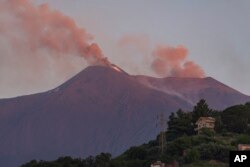Scientists appear to be one step closer to predicting volcanic eruptions. This is a problem that has plagued volcanoists for decades. A study published last week at Nature Geoscience found that using satellite observations to calculate the rate at which underground molten rock or magma accumulates beneath a volcano can predict a particular eruption weeks or months in advance. understood.
"All kinds of information that can be used to make this prediction are important, because the longer you have to warn people that you can take some action, the less the impact of the eruption. "Michael Poland, a volatologist at the US Geological Survey, told VOA. "In fact, that's all we have in terms of reducing the effects of eruptions, so that they don't get in the way."
Most volcanoes do not erupt without warning. They swell, cause small earthquakes, and release gas that leads to eruptions. This is what volcano scientists call "anxiety." However, although volcanoes rarely erupt completely suddenly, it is not uncommon for anxiety to subside without eruption.
"The challenge is to understand when and when these changes in these monitoring parameters will lead to an eruption," said Cornell University volcanoologist and lead author of a new study. One Federico Garrett told VOA. ..
Currently, Poland states that the gold standard for eruption prediction includes highly localized observations of individual volcanoes. However, most volcanoes are not closely monitored on the ground. In contrast, deformation (how a volcano swells and distorts in an unstable state) can be measured from space, even at the furthest volcanoes.
"Satellite transformation technology has actually shown that many of these volcanoes expand and contract, thereby reaching that kind of prediction" holy cup "in the absence of ground. Can help-based data. "

Unfortunately, deformation alone cannot reliably predict an eruption. However, Garrett and his colleagues thought that the magma flow rate that could be calculated using the transformation data might be better.
To investigate, they have 45 episodes of anxiety in the basal caldera, a common volcano that normally looks like a flat, wide shield of dark genbu rock, including volcanoes in Hawaii, Iceland, and the Galapagos Islands. I considered. The basal caldera has long been observed, as it is considered relatively easy to study, thanks to its relatively shallow magma chamber (a pool of molten rock beneath the surface) and frequent eruptions.
"They chose these basal calderas, a subset we have a lot of information and a lot of observations," Poland said. "These types of volcanoes, we have a lot of experience ... they tend to be great laboratories."
According to Garrett's analysis, magma flow is anxious. I was sure to predict whether it would end with a chamber rupture (usually causing an eruption) or just disappear.
All volcanoes (about 40,000 Olympic swimming pools) in the dataset with magma flow exceeding one-tenth cubic kilometers per year burst the magma chamber within a year. Even if the inflow rate was reduced to one tenth, the magma chamber did not burst in 89% of cases, and I was not worried for more than a year. Medium-flow volcanoes were difficult to predict due to factors such as rock type and magma chamber size.
"This is really promising," Garrett said. "It seems to work very well in these types of volcanoes."
According to calculations by Garrett and his team, the slowly filled magma chamber is sticky and stupid. Low magma flow tend not to cause an eruption, as it behaves like a putty or moraces and oozes outwards to accommodate slowly entering trickles. Magma without bursting. The fast flow does not just squeeze the magma chamber, but increases the pressure rapidly enough to break the magma chamber.
"It makes sense," Poland said. "The faster the balloon is blown up, the more likely it is that the balloon will pop out." But he also warned that using new results to predict a particular volcano would be a challenge. ..
"In volcano science, every volcano is different, so there is always a level of local expertise needed for your volcano," he said. "But we can learn some general trends ... when we're looking at these particular systems we're trying to predict, they help guide us in the right direction.
Based on his results, Garrett believes that magma flow can help predict eruptions weeks or months ahead of the basal caldera, but what to do is There is still. As Poland explained, fine-tuning predictive calculations using volcanic-specific data is as good as collecting and analyzing satellite deformation data to make good predictions. He said it was important.
"My paper is just a starting point, not an ending point," Garrett said. "We need to see if we can find this relationship in other volcanoes. Another point is not only in the group of volcanoes I studied for these results, but also in other groups. It's about to expand. Of the volcano. And it will be much more complicated. "


